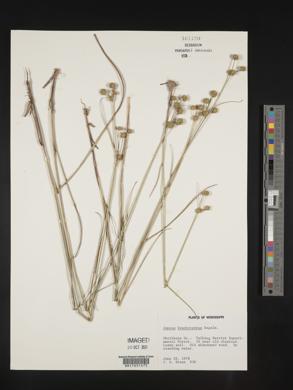Juncus brachycarpus
|
|
|
|
Family: Juncaceae
White-Root Rush
|
Herbs, perennial, not cespitose, rhizomatous, (3--)4.5--8(--9) dm. Rhizomes tuberous, 3--4 mm diam. Culms erect, terete, 2--3 mm diam., smooth. Cataphylls 0(--1), straw-colored, apex acute. Leaves: basal 1--2, cauline 2--4, auricles 0.5--3.5 mm, apex rounded, scarious; blade green to straw-colored, terete, 3--50 cm x 1--2 mm diam. Inflorescences terminal panicles of 2--10(--20) heads or a single head, 1--4(--10) cm, branches ascending; primary bract erect; heads 30--100-flowered, spheric, 8--10 mm diam. Flowers: tepals green to straw-colored, often red-tinted, lanceolate-subulate, apex acuminate; outer tepals 2.5--3.8 mm; inner tepals 2--3.2 mm; stamens 3, anthers 1/4--1/2 filament length. Capsules included, chestnut brown, 1-locular, obconic or ovoid, 1.8--2.7 mm, apex obtuse, valves separating at dehiscence, fertile throughout or only proximal to middle. Seeds ellipsoid to oblique-oblong, 0.3--0.4 mm, not tailed; cody clear to yellow-brown. 2n = 44. Fruiting mid summer--fall. Damp clayey, peaty, or sandy soils, swamps, ditches, ponds, wet woods, wet prairies; 0--500 m; Ont.; Ala., Ark., Conn., Del., Fla., Ga., Ill., Ind., Kans., Ky., La., Md., Mass., Mich., Minn., Miss., Mo., N.J., N.Y., N.C., Ohio, Okla., Pa., S.C., Tenn., Tex., Va., W.Va. Perennial grasslike forb 0.4 - 0.9 m tall Leaves: one or two basal and two to four alternate on stem, green to straw-colored, 3 - 50 cm long, 1 - 2 mm diameter, linear, grasslike, round in cross section, and with distinct crosswise partitions inside (septate). The leaves also have a thin and papery, basal, 0.5 - 3.5 mm long, round-tipped, ear-like appendage (auricle) at the top of the leaf sheath. Inflorescence: a terminal, 1 - 8 cm long, ascending-branched structure with branches ending in two to twenty (sometimes only one), spheric, 0.8 - 1 cm diameter flower clusters. Each flower cluster is a compact head of 30 to 100, tiny, radially symmetric flowers. Stamens: three, shorter than tepals, with anthers one-third to one-half the length of the filaments. Pistil: with one superior ovary, and three stigmas. Fruit: single-chambered, chestnut-brown,1.8 - 2.7 mm tall (shorter than tepals), inversely cone- or egg-shaped (widest beyond middle), blunt-tipped capsules, which open down the sides. Stems: erect, smooth, round in cross section, 2 - 3 mm diameter, and arising from tuberous rhizomes 3 - 4 mm in diameter. Seeds: many, clear yellow-brown, 0.3 - 0.4 mm long, ellipsoid to slightly oblong with short-pointed or abruptly narrowed tips, but without distinct narrowed tails at the ends. Tepals: six in two whorls of three, green to straw-colored, often tinted with red, very narrowly lance-shaped with long-tapered, slender, pointed tips. The three outer tepals are longer (2.5 - 3.8 mm) than the three inner tepals (2 - 3.2 mm). Similar species: Juncus brachycarpus is similar to J. scirpoides, but that species has taller and more slender capsules which are much taller than the tepals. Some odd plants of J. nodosus with three stamens may be confused with J. brachycarpus, but in that species the outer tepals are shorter than or only as tall as the inner three tepals. Also possibly confusing is J. acuminatus, but its flower heads are typically only hemispheric (and fewer flowered), its tepals are not as long-tapering and pointed, the capsule and tepals are about the same height, and the capsules are widest at or below their middles and have pointed tips. Flowering: June to September Habitat and ecology: Not common, occasionally found along the edges of sandy swales or sloughs, also in some moist prairies, and even sometimes in old fields. Occurence in the Chicago region: native Author: The Field Museum Stems erect, 3-8 dm, aligned on a stout rhizome; lvs terete, septate; infl 2-10 cm, open or congested, with 3-10(-20) bristly, globose, densely many-fld heads 1 cm thick; fls eprophyllate; tep lance-subulate, the sep 3.2-3.8 mm, the pet 2.2-3.2 mm; stamens 3, shorter than the tep; fr unilocular, trigonously oblong-prismatic, abruptly acute and mucronate, 1.5-2.7 mm, nearly concealed within the perianth; 2n=44. Damp or wet soil; Mass. to Ga.; s. Ont. to O., Minn., and Kans., s. to Miss. and Tex. Gleason, Henry A. & Cronquist, Arthur J. 1991. Manual of vascular plants of northeastern United States and adjacent Canada. lxxv + 910 pp. ©The New York Botanical Garden. All rights reserved. Used by permission. From Flora of Indiana (1940) by Charles C. Deam Fairly common in southern Indiana; frequent elsewhere except in the central and eastern counties. Its favorite habitats are low fallow or grassy fields where the soil is usually a hard white clay, and sandy ditches, but it occurs also on wet roadsides and in flat woods and on the dunes in sloughs and sandy swales. …… Indiana Coefficient of Conservatism: C = 4 Wetland Indicator Status: FACW |






















































































